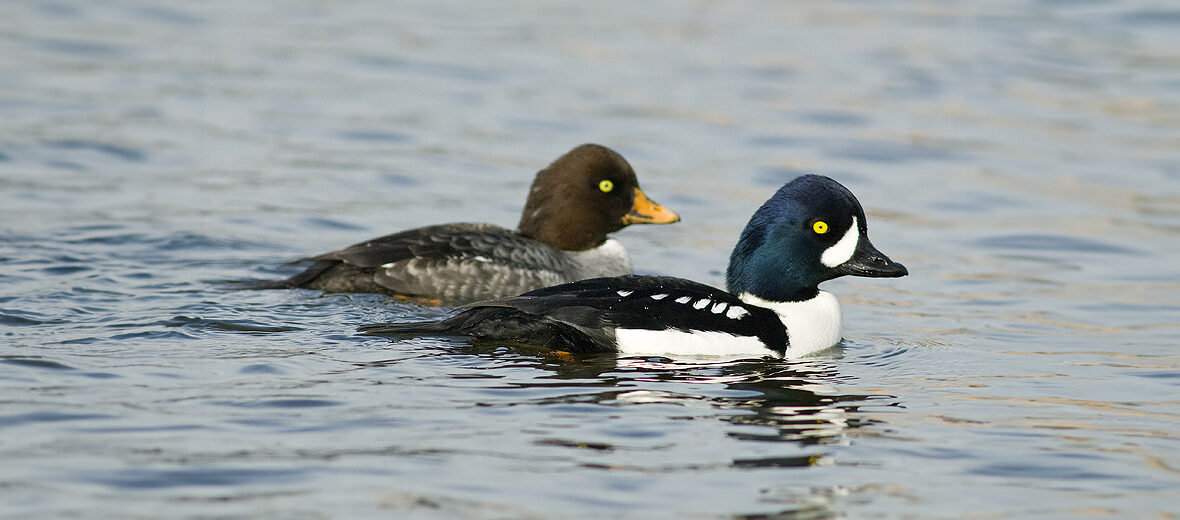
The Barrow’s goldeneye is a mid-sized sea-faring duck with quite a spaced out distribution. These critters can be found in Canada, Iceland, United States, and possibly Scotland. These ducks face many threats such as habitat loss and destruction at the hands of residential and commercial developments, logging, fires, and fire suppression; hunting; trapping; invasive species, and with them disease and/or predation; pollution; and climate change, which can cause habitat shifting and alteration. The IUCN lists these birds as Least Concern.
First the Stats…
Scientific name: Bucephala islandica
Weight: Up to 2.13 lbs.
Length: Up to 19.2 inches
Wingspan: Up to 28.7 inches
Lifespan: Up to 18 years
Now on to the Facts!
1.) Despite all the threats they face, these birds number an estimated 200,000 and have a stable population, and thus are listed as Least Concern by the IUCN.
2.) Their vocalizations are few and far between, and consist of rather quiet croaks, grunts, and squeaks.
3.) These ducks were named after Sir John Barrow, an English geographer, linguist, civil servant, and writer.
4.) The genus name hails from Ancient Greek boukephalos, meaning “bullheaded”, from bous, meaning “bull” and kephale, meaning “head”; which is a reference to the bulbous shape of the bufflehead. The species name islandica translates to Iceland.
5.) They were formally described in 1789 by the German naturalist Johann Friedrich Gmelin in his expanded and revised edition of Carl Linnaeus’s Systema Naturae.
But wait, there’s more on the Barrow’s goldeneye!
6.) The Barrow’s goldeneye is now placed, however, with the common goldeneye and the bufflehead within the genus Bucephala that was introduced back in 1858 by American naturalist Spencer Baird.
7.) These birds are migratory and they, as well as many other sea ducks, rely heavily on urbanized coastal estuaries for their migration patterns.
Did you know…?
In Iceland, these ducks are known as húsönd, which translates to house duck.
8.) They are diving ducks that feed on various crustaceans, aquatic insects, mussels, gastropods, and pond vegetation.
9.) Despite being water birds, these critters are actually considered arboreal (spend part of their lives in trees) because they nest in the cavities of mature trees.
10.) Territorial displays are shown along the boundaries of their territories. This usually causes other drakes (males) to engage in their own displays. These territorial displays only last upwards of 6 minutes at a time.
But wait, there’s still more on the Barrow’s goldeneye!
11.) Seasonal molting lasts up to 40 days. During this time, they are flightless. So, they tend to molt away from human or predator inhabited areas for safety.
12.) Barrow’s goldeneyes were significantly affected by the Exxon Valdez oil spill in 1989. The spill dramatically effected the bird’s wintering areas, and large numbers of the birds in these areas decreased following the spill.
13.) Bald eagles, golden eagles, great horned owls, American black bears, raccoons, American martens, fishers, minks, and squirrels, to name a few, all prey on these ducks.
Now a Short Barrow’s Goldeneye Video!
Be sure to share & comment below! Also, check out the Critter Science YouTube channel. Videos added regularly!
Want to suggest a critter for me to write about? Let me know here.
Some source material acquired from: Wikipedia & IUCN
Photo credit: iNaturalist




